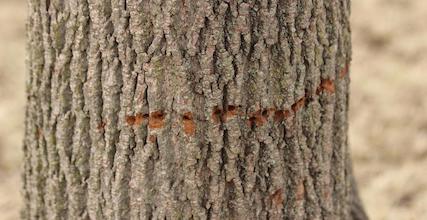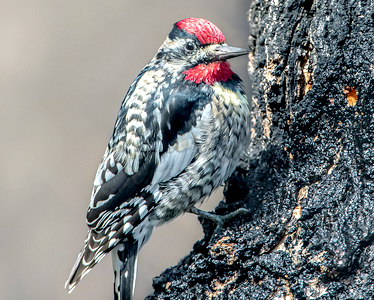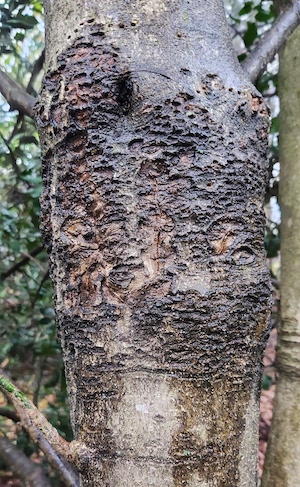Sure, They’re Cute Birds – But They’re Sapsuckers!
by Elaine Pugh, Fairfax Master Gardener

Sapsucker damage on tree
I never saw them. I never heard them. Yet their signature calling card was exactly the damage I was experiencing on one of my holly trees. Specifically, evenly-spaced small circular holes around the trunk of my tree in lines parallel to the ground. Sapsucker damage.
The culprit is Sphyrapicus varius, the Yellow-Bellied Sapsucker. The males, about 7 to 8 inches (17 to 20 cm) in length, are black and white with a long vertical white stripe on the folded wing, a red cap and a red throat patch. The underside varies from pale yellow to whitish. The females look similar but have a white throat patch.
Sapsuckers are a type of woodpecker that isn’t looking for insects buried in trees. They are literally after the sweet sap in the tree. And not just any tree. They left my other three Nellie Stevens Hollies alone. They hit that one tree that has what professionals call the X factor, that one tree that apparently has especially sweet sap to them.

Male Sapsucker
And they don’t just feed on holly trees. These sapsuckers feed on over 1,000 species of trees and shrubs, but favor trees with smoother bark. Examples include maple (Acer), birch (Betula), oak (Quercus), spruce (Picea), hemlock (Conium maculatum), beech (Fagus), apple (Malus), serviceberry (Amelanchier), Bradford pear, (Pyrus calleryana), pine (Pinus), yew (Taxus), Magnolia and others.
On the chosen tree, the sapsucker will drill two types of holes into the trunk, called sap wells or feeding wells, approximately 1/4 inch (6 mm) in diameter. The first are round holes that the bird drills deep into the tree to probe for sap. The second are shallower, rectangular, elongated holes regularly worked by the sapsuckers to keep the sap flowing. This sap makes up about 20 percent of the bird’s diet. The birds also feed on the soft inner tree bark and insects such as ants that are attracted to the sap, as well as fruit and seeds.

Extensive sapsucker damage
Compared to most woodpeckers, sapsuckers are migratory. The sexes in our area winter separately. Males leave the northeast in the fall and typically winter in the southern states, such as Virginia, while most females leave the country in the fall and travel to the West Indies, Mexico and Central America. They both head north again in the early spring. (An exception to this migration is the higher elevation of the western mountains in Virginia where they can remain year-round.) Photo of migration map.
These birds seem to do the same damage to the trees, whether located in their breeding area or their wintering area, although the USDA Forest Services says that it does vary by the tree species and the season. Most trees should recover from minor sapsucker damage. However, if not addressed, an excessive number of holes with repeated damage over time can invite insects and decay fungi to enter the holes and cause secondary damage to stress the tree. An excessive number of holes can also result in cambium girdling, preventing the flow of sap within the tree’s circulation system, killing the tree. Photo with excessive damage

Range map
Treating the tree wound holes could do more harm than good. The best advice is to try to discourage the birds from drilling the holes by covering the holes in the trunks with burlap or similar material before they arrive in the early fall and remove it after they migrate in the spring. Don’t leave the burlap up year-round. Other options are chicken wire around the trunk, hanging reflective old CDs, pie plates or reflective tape from branches, or draping the tree with netting. Killing these birds is prohibited, as they are protected by the Federal Migratory Bird Treaty Act, and regulated by the US Fish and Wildlife Resources and the Virginia Department of Wildlife Resources.
Do you have sapsucker damage? Now is the time to find out. If so, you may actually see a Yellow-Bellied Sapsucker, but in this area of Virginia it will probably be the male as the female may very well be vacationing in Mexico.
References
Woodpecker and Sapsucker Damage on Trees, University of Maryland Extension
Managing Human-Wildlife Interactions: Woodpeckers, Virginia Cooperative Extension, Jim Parkhurst
Yellow-bellied Sapsuckers, Kerry Wixted, Maryland Department of Natural Resources
Recognizing Sapsucker Damage in Yard Trees, Brady Self, Forestry, Mississippi State Extension
Yellow-bellied Sapsuckers (Sphyrapicus varius), Parker Johnson, Clemson Cooperative Extension